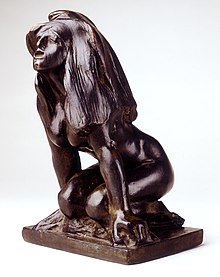Succubus

A succubus (pl.: succubi) is a
Etymology
The term derives from Late Latin succuba "paramour" from succubare "to lie beneath" (sub- "under" and cubare "to lie"),[1] used to describe this being's implied sexual position relative to the sleeper's position. The English word "succubus" dates from the late 14th century. The succubus is also known as the earth wanderer.[2][3]
In folklore
As depicted in the Jewish mystical treatise .
Throughout history,
Ability to reproduce
According to the
According to the Malleus Maleficarum, or Witches' Hammer, written by Heinrich Kramer (Institoris) in 1486, succubi collect semen from men they seduce. Incubi, or male demons, then use the semen to impregnate human females,[12] thus explaining how demons could apparently sire children, despite the traditional belief that they were incapable of reproduction. Children so begotten—cambions—were supposed to be those that were born deformed, or more susceptible to supernatural influences.[13]
In non-Western literature
Buddhist canon
A Buddhist scripture regarding prayer to Avalokiteśvara, the Dharani Sutra of Amoghapāśa, promises to those who pray that "you will not be attacked by demons who either suck your energy or make love to you in your dreams."[15]
Arabian mythology
In
See also
- List of mythological creatures
- List of succubi in fiction
References
- ^ "Succuba". dictionary.com.
- ^ "succubus". Oxford English Dictionary (Online ed.). Oxford University Press. (Subscription or participating institution membership required.)
- ^ Ha, Douglas. "Succubus". Online Etymology Dictionary.
late 14c., alteration (after incubus, giving a masc. form to a word generally felt as of female meaning) of Late Latin succuba
- OCLC 20692501.
- ^ ISBN 978-90-04-17752-9.
- ^ "Zohar: Chapter XXXII". Internet Sacred Text Archive.
- ISBN 978-0313393433.
- ISBN 978-1438126845.
- ^ Geoffrey W. Dennis, The encyclopedia of Jewish myth, magic and mysticism. p. 126
- ^ "History of the Succubus". cyodine.com. Archived from the original on 17 July 2004.
- ^ Humm, Alan. "Kabbala: Lilith, Queen of the Demons". lilithgallery.com. Retrieved 21 September 2016.
- ^ Kramer, Heinrich and Sprenger, James (1486), Summers, Montague (translator – 1928), The Malleus Maleficarum, Part2, chapter VIII, "Certain Remedies prescribed against those Dark and Horrid Harms with which Devils may Afflict Men," at sacred-texts.com
- ISBN 0-7876-0652-9
- ISBN 978-1-5329-6891-4.
- ISBN 023112029X.
- ^ a b Zwemer, Samuel M. (1939). "5". Studies in Popular Islam: Collection of Papers dealing with the Superstitions and Beliefs of the Common People. London: Sheldon Press.
- ^ Tremearne, A. J. N. (1914). Ban of the Bori: Demons and Demon-Dancing in West and North Africa.
- ^ Trimingham, J. Spencer (1965). Islam in the Sudan. London: Frank Cass & Co. Ltd. p. 172.
Further reading
- Grover, S.; Mehra, A.; Dua, D. (January–June 2018). "Unusual cases of succubus: A cultural phenomenon manifesting as part of psychopathology". Ind Psychiatry J. 27 (1): 147–150. PMID 30416306.
